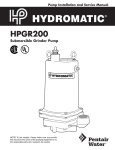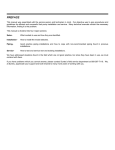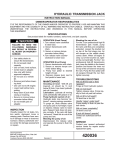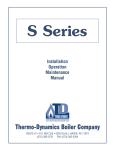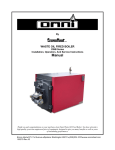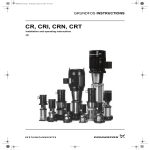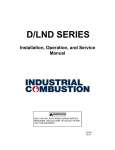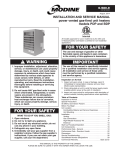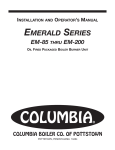Download Modine Manufacturing PAE Service manual
Transcript
75-551.5 December, 2003 SERVICE DIAGNOSIS Modine heating & ventilating equipment A Problem/Remedy Guide for Modine: Gas-Fired Unit Heaters Gas-Fired Duct Furnaces Steam/Hot Water Unit Heaters Electric Unit Heaters Oil-FIred Unit Heaters Infra-Red Heaters The Modine Service Diagnosis Guide was compiled as a trouble shooting guide intended to define the most common types of service problems found with heating equipment, the possible causes of these problems, and possible remedies. This trouble shooting guide, used in conjunction with the appropriate product Installation and Service Manual, should enable a serviceperson to identify, investigate and resolve most field service problems found with industrial/commercial unit heaters. Remember: When servicing any unit heater locate the rating plate and record the model number, power code number, control code number, and serial number shown. This information is required to identify components and date of manufacture. If a service problem is encountered which can not be resolved with the use of this service guide, and the appropriate installation and service manual, further assistance can be obtained by contacting your local Modine factory representative. TABLE OF CONTENTS PROBLEM A. B. See Page UNIT WILL NOT OPERATE . . . . . . . . . . . . . . . . . . . .3 All Units Gas-Fired Units Oil-Fired Units Electric Units PILOT WILL NOT LIGHT OR STAY LIT . . . . . . . . . . .3 Gas-Fired Units Duct Furnaces Infra-Red Heaters C. PILOT FLAME NOT NORMAL . . . . . . . . . . . . . . . . .4 Gas-Fired Units Infra-Red Heaters D. BURNER WILL NOT LIGHT OR STAY LIT . . . . . .4, 5 Gas-Fired Units Infra-Red Heaters Oil-Fired Units E. F. BURNER FLAME IS NOT NORMAL . . . . . . . . . . .5, 6 Gas-Fired Units Infra-Red Heaters Oil-Fired Units BURNER WILL NOT SHUT-OFF . . . . . . . . . . . . . . . .6 All Units Gas-Fired Units Infra-Red Heaters G. BURNER SHUTS OFF TOO SOON . . . . . . . . . . . . . .6 All Units H. CONTROL FAILURE . . . . . . . . . . . . . . . . . . .6, 7, 8, 9 Gas-Fired Units Infra-Red Heaters I. MOTOR FAILURE . . . . . . . . . . . . . . . . . . . . . . . . 9, 10 All Units J. FAN OPERATES BUT BURNER DOES NOT OPERATE . . . . . . . . . . . . . . . . . . . . . . . . . . . . . . . .10 Gas-Fired Units Oil-Fired Units K. L. BURNER OPERATES BUT FAN WILL NOT OPERATE . . . . . . . . . . . . . . . . . . . . . . . . . . . . . . . .10 Gas-Fired Units Oil-Fired Units BURNER MOTOR DOES NOT START . . . . . . . . . .10 Oil-Fired Units M. BURNER MOTOR OPERATES BUT NO OIL DELIVERED AT NOZZLE . . . . . . . . . . . . . . . . . . . .11 Oil-Fired Units N. 2 BURNER MOTOR OPERATES, DELIVERS OIL, BUT NOT FLAME . . . . . . . . . . . . . . . . . . . . . . . . . .11 Oil-Fired Units PROBLEM P. See Page NO GAS OR NO OIL . . . . . . . . . . . . . . . . . . . . .11, 12 Gas-Fired Units Oil-Fired Units Q. OIL LEAK OR GAS LEAK . . . . . . . . . . . . . . . . . . .12 Gas-Fired Units Oil-Fired Units R. INSUFFICIENT HEAT . . . . . . . . . . . . . . . . . . . .12, 13 All Units Gas-Fired Units Electric Units Steam/Hot Water Units S. TOO MUCH HEAT . . . . . . . . . . . . . . . . . . . . . . . . . .13 All Units Gas-Fired Units T. FUEL ODORS . . . . . . . . . . . . . . . . . . . . . . . . . . . . .13 Gas-Fired Units Oil-Fired Units U. NOISY OPERATION . . . . . . . . . . . . . . . . . . . . . . . .14 All Units Gas-Fired Units Oil-Fired Units V. PULSATING PRESSURE . . . . . . . . . . . . . . . . . . . .14 Gas-Fired Units Oil-Fired Units W. LOW OIL OR GAS PRESSURE . . . . . . . . . . . . . . .14 Gas-Fired Units Oil-Fired Units X. NOISE OF IGNITION OR EXTINCTION . . . . . . . . . .15 Gas-Fired Units Oil-Fired Units Y. CONDENSATION PROBLEMS . . . . . . . . . . . . . . . .15 Gas-Fired Units Infra-Red Heaters Z. HEAT EXCHANGER FAILURE . . . . . . . . . . . . .15, 16 Gas-Fired Units Oil-Fired Units Steam/Hot Water Units AA. UNIT CYCLES ON OVERHEAT . . . . . . . . . . . . .16, 17 All Units BB. CORROSIVE DAMAGE . . . . . . . . . . . . . . . . . . . . . .17 Gas-Fired Units Oil-Fired Units Steam/Hot Water Units CC. THERMOSTAT PROBLEMS . . . . . . . . . . . . . . .17, 18 All Units Problem A. Possible Remedy Unit Will Not Operate 1. Electrical circuit in open position. 1. Turn on power, turn up thermostat, or replace fuse(s) and reset disconnect. All Units 2. Defective or incorrectly adjusted thermostat. 2. Replace or adjust thermostat. 3. Defective or incorrect wiring. 3. Check wiring and connections. If necessary rewire unit according to Modine wiring diagram. 4. Inoperable or defective automatic controls. 4. Check controls and replace if required. See “Control Failure,” pages, 6, 7, 8, 9. 5. Motor failure. 5. See “Motor Failure,” pages 9. 10. 1. Main manual gas valve inoperable or in closed position. 1. Open main manual valve or replace defective valve. 2. Pilot light extinguished. 2. Light pilot. 1. No oil. 1. Fill oil tank, or open supply valve, or check filter. 2. Primary control locked out on safety. 2. Push reset button on primary control only if heat exchanger is cool. Try this only twice. See control service instructions in Installation Manual. 3. Defective cad cell. 3. Replace cad cell if necessary. Check continuity. 4. Burner or fan motor out on overload. 4. Check voltage, wiring and motor. Reset overload button on burner motor. Fan motor automatically resets. 1. Blown fuses. 1. Replace fuses. Check for cause of blown fuses. 2. Defective or burned out transformer. 2. Check secondary voltage with voltmeter. Replace if necessary. Pilot Will Not Light or Stay Lit 1. Pilot valve inoperative or in closed position. 1. Open pilot valve or replace defective pilot valve. Gas-Fired Units, Duct Furnaces and Infra-Red Heaters 2. Safety pilot reset button or plunger not depressed correctly or safety pilot valve defective. 2. Refer to manufacturer’s lighting instructions on serial plate and relight pilot. Replace safety pilot valve. 3. Pilot line clogged. 3. Clean or replace. 4. Pilot orifice clogged. 4. Clean or replace. 5. Pilot flame too low or too high. 5. Adjust pilot per manufacturer’s recommendations. 6. Air in pilot line. 6. Purge air from pilot line as per manufacturer’s recommendations. 7. Excessive draft blowing pilot away from thermocouple. 7. Either move or shield unit from draft. 8. Loose or dirty thermocouple connections or defective thermocouple. 8. Tighten or clean connections. Replace defective thermocouple. 9. Pilot being blown out when excessive gas remains in burner on ignition or extinction causing flashback. 9. See “Burner Flame is Not Normal,” pages 5, 6. Gas-Fired Units Oil-Fired Units Electric Unit Heaters B. Possible Cause 10. Flame impinging on cold joint of thermocouple from loose pilot tube connection. 10. Tighten all pilot tube fittings. 3 Problem C. D. 4 Possible Cause Possible Remedy Pilot Flame is Not Normal 1. Lazy yellow flame 1. Pilot orifice too large. 1. Check orifice size. 2. Waving blue flame 2. Excessive draft at pilot. 2. Either move or shield unit from draft. 3. Small blue flame 3. Low gas pressure. 3. Check gas pressure and adjust as per manufacturer’s recommendations. 4. Flame being lifted off pilot burner 4. Gas pressure too high. 4. Check gas pressure and adjust as per manufacturer’s recommendations. 5. Hard sharp flame 5. Pilot orifice too small. 5. Check orifice size. Burner Will Not Light or Stay Lit 1. Electrical circuit in open position. 1. Turn on power, turn up thermostat, or replace fuse(s) and reset disconnect switch. Gas-Fired Units and Infra-Red Heaters 2. Main manual gas valve closed or inoperative. 2. Open valve or replace defective valve. 3. Pilot extinguished. 3. Relight pilot. 4. Defective or incorrect wiring. 4. Check wiring and connections. If necessary rewire unit according to proper wiring diagram. 5. Pilot flame too low. 5. Adjust pilot per manufacturer’s recommendations. 6. Inoperative or defective automatic controls. 6. Check controls and replace if required. See “Control Failure,” pages 6, 7, 8, 9. 7. Excessive draft blowing pilot away from thermocouple. 7. Move or shield unit from draft. 8. Loose or dirty thermocouple connections or defective thermocouple. 8. Tighten or clean thermocouple connections. Replace defective thermocouple if necessary. 9. Defective or damaged burner. 9. Replace burner. 10. Excessive primary air. 10. Adjust primary air per manufacturer’s recommendations. See Installation Manual. 11. Carry-over ports on burner plugged. Lint or spider webs in venturi tubes or bugs or obstructions in main burner orifices. 11. Clean and replace if necessary. 12. Improper pilot location. 12. Reposition pilot. 13. Mis-aligned burner. 13. Align burner with main burner orifices. 14. Low gas pressure. 14. Check gas pressure and adjust as per manufacturer’s recommendations. 15. Unit Installed with pilot on low side of units mounted on an angle (infra-red only). 15. Reinstall unit with pilot on high side as per manufacturer’s recommendations. 16. Low pilot gas pressure on milli-volt control system for infra-red unit. 16. Check pilot gas pressure and adjust to recommended water column. Problem D. Possible Cause Possible Remedy Burner Will Not Light or Stay Lit (continued) 1. Burner motor runs but no spark. 1. Check electrode spacing or replace ignition transformer. Oil-Fired Units 2. Primary control locked out on safety. 2. Push reset button on primary control only if heat exchanger is cool. Try this only twice. See Control Service Instructions in Installation Manual. 3. Defective cad cell. 3. Replace cad cell if necessary. Check continuity. 4. Burner or fan motor out on overload. 4. Check voltage, wiring and motor. Reset overload button on burner motor. Fan motor automatically resets. 5. Clogged nozzle. 5. Replace nozzle. Use only exact replacement. See Installation Manual for size and type. 6. Air leaks in suction line. 6. Tighten all fittings. 7. Faulty ignition. 7. a. Reset electrodes in burner assembly. Check insulators. b. Check wiring at primary control. c. Replace ignition transformer, if required. d. Check for proper contact between transformer springs and electrode bus bars. E. 8. High draft, too much air. 8. Check draft regulator adjustment. Adjust combustion air openings on burner. 9. Improper oil pressure. 9. Adjust fuel pump using pressure gauge for proper setting. Burner Flame is Not Normal Gas-Fired Units 1. Long yellow tipped flames. 2. Flames lifting from burner. 3. Flame unstable. 1a. Lack of combustion air in building. 1a. Provide proper combustion air. 1b. Insufficient primary air. 1b. Increase primary air by adjusting primary air shutters back, or adjusting burner manifold back. 1c. Main burner orifices incorrectly sized. 1c. Check main burner orifice size against manufacturer’s recommended sizes. 1d. Clogged burner ports, damaged burner. 1d. Clean or replace burner if necessary. 1e. Mis-aligned main burner orifice(s). 1e. Re-align orifices with burner. 1f. Vent obstruction. 1f. Clean vent pipe. 2a. Excessive gas pressure. 2a. Check gas pressure and adjust per manufacturer’s recommendations. 2b. Main burner orifices incorrectly sized. 2b. Check main burner orifices size against manufacturer’s recommendations. 2c. Defective regulator. 2c. Replace regulator. 3a. Excessive draft. 3a. Move unit or shield unit so flames will not be affected by draft. 3b. Defective regulator. 3b. Replace regulator. 4. Flashback at extinction of burner flame. 4a. Ports of burner too large. 4a. Repair or replace burner. 4b. Excessive primary air. 4b. Reduce primary air by moving primary air shutters forward, or adjusting burner manifold forward. 5. Flashback on burner ignition. 5. 5. Excessive primary air. Reduce primary air by moving primary air shutters forward. 5 Problem E. Possible Cause Possible Remedy Burner Flame is Not Normal (continued) Infra-Red Heaters 1. Gas burning at orifice. 1b. Replace ceramics. 1c. Loose or missing seal in ceramic mounting frames or under ceramics mounting frames. 1c. Inspect and replace if necessary. 1d. Warped burner or ceramic mounting frames. 1d. Replace. 2a. Low gas pressure. 2a. Check gas pressure and adjust as per manufacturer’s recommendations. 2b. Mis-aligned main burner orifice. 2b. Re-align burner orifice. 2c. Incorrectly sized main burner orifice. 2c. Check main burner orifice size against manufacturer’s recommended sizes. 1. Excessive combustion air. 1. See start-up procedure in Installation Manual. 2. Excessive draft. 2. Adjust draft regulator. See Installation Manual. 3. Poor atomization of oil. 3. Change nozzle with same type and capacity. 4. Uneven flame. 4. Change nozzle with same type and capacity. Burner Will Not Shut Off 1. Unit wired incorrectly. 1. Check wiring and rewire if necessary. All Units 2. Thermostat set too high. 2. Reset thermostat. 3. Thermostat wire shorted. 3. Correct short. 4. Short circuit in wiring. 4. Check wiring and correct. 5. Thermostat out of calibration or defective. 5. Recalibrate or replace. 1. Dirt under gas valve seat. 1. Replace valve. 2. Ruptured gas valve. 2. Turn off gas at manual valve. Check line pressure to gas controls and adjust per manufacturer’s recommendation. Replace gas valve. 1. Thermostat out of calibration or defective. 1. Recalibrate or replace thermostat. 2. Unit is cycling on overheat control. 2. See “Unit Cycles on Overheat,” pages 16, 17. 3. Defective overheat control. 3. Replace. Oil-Fired Units Gas-Fired Units and Infra-Red Heaters G. Burner Shuts Off Too Soon All Units H. 1a. Tighten screws. 1b. Cracked ceramics. 2. Burner color appears dull red, not bright. F. 1a. Loose screws holding ceramic mounting frames. Control Failure Gas-Fired Units Standing Pilot Systems 1. Pilot Will Not Light or Stay Lit. 1a. Defective thermocouple. 1a. Check and replace if necessary. 1b. Dirty thermocouple connections. 1b. Clean. 1c. Inoperative magnetic pilot valve operator. 1c. Replace. 1d. Gas valve turned to off position. 1d. Turn to pilot position. 1e. Condensate in pilot line. 1e. Clean. 1f. Inoperative pressure sensing switch (power vented models only). 6 aa. Defective switch. aa. Replace switch. bb. Vacuum leaks at power venter housing connection. bb. Seal leaks. cc. Excessive static pressure in vent system. cc. Check venting for compliance with manufacturer’s recommendations. Problem 1. Pilot Will Not Light or Stay Lit (continued). 2. Main Burner Will Not Light. Possible Cause Possible Remedy dd. Unit over fired. dd. Adjust to proper input. ee. Negative pressure in building. ee. Correct building negative pressure conditions. ff. ff. Blower drive not set correctly; blower running too slow. Adjust air blower per manufacturer’s recommendations. 2a. Defective electric operator. 2a. Replace. 2b. Gas valve turned to OFF or PILOT position. 2b. Turn to ON position. 2c. Unit mis-wired or loose connections. 2c. Check all connections and rewire if necessary. 2d. Loose connections on limit control or defective limit control. 2d. Check wiring. Replace limit control if defective. 2e. Defective or plugged gas valve regulator. 2e. Inspect gas valve regulator. Replace if defective. 2f. Defective thermostat or thermostat out of calibration. 2f. Calibrate thermostat or replace if necessary. 2g. Thermostat heat anticipator incorrectly set (low voltage controls). 2g. Check anticipator setting and correct if necessary. 2h. Power venter centrifugal switch not closing or wired incorrectly. 2h. Check centrifugal switch if unit is supplied with a power venter. Check wiring. Check power venter motor. 2i. On units equipped with energy cut-off (ECO) device fuse in energy cut-off may be blown or defective. 2i. If fuse if blown, replace fuse and determine reason for blown fuse. The ECO is an over heat protection control and the cause of overheating must be corrected before putting the equipment back into service. (See Section “AA”). 1a. No spark at ignitor. 1a. Check connections. Check for proper spark gap, cracked or broken electrode ceramic, blown controller fuse or brittle, cracked or loose high tension cable. 1b. Defective flame sensor or loose connections to flame sensor. 1b. Check mili-amps of sensor. Tighten loose connections. Replace flame sensor if necessary. 1c. Pilot valve electrical connections loose. 1c. Tighten connections. 1d. Defective pilot valve. 1d. Replace. 1e. Poor ground connections. 1e. Check grounding means. 1f. No power from control transformer. 1f. Check transformer voltage on secondary side for 25V. 1g. Spark not located in pilot gas stream. 1g. Correct or replace pilot. 1h. Dirty or plugged pilot orifice. 1h. Clean or replace. 1i. Pilot line kinked or obstructed. 1i. Correct or replace pilot line. 1j. Pilot flame too low. 1j. Check pilot flame and adjust per manufacturer’s recommendations. 1k. Flame sensor out of position. 1k. Reposition. 1l. Defective ignition controller. 1l. Replace. 1m. Dirty flame sensor. 1m. Clean or replace. Gas-Fired Units Intermittent Pilot Ignition Systems 1. Pilot Will Not Light or Stay Lit. 7 Problem Possible Cause Possible Remedy Gas-Fired Units Intermittent Pilot Ignition Systems (continued) 2. Pilot Lights, Main Burner Will Not Light. 2a. Turn to on position. 2b. System in lock-out mode. 2b. Reset system. 2c. Cracked or broken sensor ceramic. 2c. Replace sensor. 2d. Defective or loose connections to flame sensor or flame sensor lead. 2d. Correct or replace. 2e. Incorrect gas pressure. 2e. Check and adjust if necessary to manufacturer’s recommendations. 2f. Insufficient current signal from flame sensor. 2f. Check current according to manufacturer’s recommendations and replace if necessary. 2g. Incorrect or loose wiring. 2g. Check wiring. 2h. Poor ground to ignition controller. 2h. Check grounding means. 2i. No power to ignition controller or gas valve. 2i. Check voltage to controller and gas valve. 2j. Loose limit control connections or defective limit. 2j. Check connections. Replace limit control if necessary. 2k. Defective or plugged gas valve regulator. 2k. Inspect gas valve regulator. Replace if necessary. 2l. Defective thermostat or out of calibration. 2l. Calibrate thermostat or replace if necessary. 2m. Thermostat heat anticipator incorrectly set. 2m. Check anticipator setting and correct if necessary. 2n. Defective ignition controller. 2n. Replace. 2o. Dirty flame sensor. 2o. Clean or replace. 2p. Power venter centrifugal switch or vacuum switch not closing or wired incorrectly. 2p. Check centrifugal switch or vacuum switch if unit is supplied with a power venter. Check wiring. Check power venter motor. Check vent pipe for obstructions. 3. 3. System Goes Into Lock-Out. 3. 4. System Shuts Down Before Thermostat is Satisfied. 4a. Defective thermostat or incorrect heat anticipator setting. 5. 8 2a. Gas valve in off position. System Fails to Shut-Off after Thermostat is Satisfied. Refer to “Pilot will not light or stay lit”. Reset system. If lock-out persists, check causes listed for “Pilot will not light or stay lit,” page 3. 4a. Check heat anticipator setting. Replace defective thermostat. 4b. Defective ignition controller. 4b. Replace. 4c. Failure of flame sensing circuit. 4c. Check for cracked or broken ceramic of flame sensor, loose connections. Replace if defective. 4d. Insufficient current signal from flame sensor. 4d. Check flame sensor location to be sure it is correctly located. 4e. System is in lock-out mode. 4e. Reset system. 5a. Defective thermostat or incorrectly set heat anticipator. 5a. Check heat anticipator setting. Replace defective thermostat. 5b. Defective ignition controller. 5b. Replace. 5c. Defective gas valve. 5c. Replace. Problem Possible Cause Possible Remedy Infra-Red Heaters Direct Spark Ignition Systems 1. No Spark. 2. Spark, but Main Burner Will Not Light. 3. Spark Stays on After Main Burner is Lit. I. 1a. Thermostat defective or incorrectly set heat anticipator. 1a. Check thermostat and anticipator setting. Replace thermostat if necessary. 1b. Ignitor ceramic cracked or broken. 1b. Replace. 1c. Incorrect spark gap. 1c. Check for proper spark gap or replace pilot ignitor. 1d. Poor ground connection. 1d. Correct. 1e. Loose connections on ignition cable. 1e. Tighten connections. 1f. Ignition cable deteriorated. 1f. Replace. 1g. Blown fuse on ignition controller. 1g. Replace. 1h. No power to controller. 1h. Check for loose wires. Check voltage on secondary side of control transformer for 25V supply. 2a. No power to main gas valve. 2a. Check voltage. 2b. Defective main gas valve. 2b. Replace. 2c. Poor ground. 2c. Correct ground. 3a. Loss of continuity of flame sensor wire. 3a. Check flame sensor wire continuity. 3b. Ignition cable deteriorated. 3b. Replace. 3c. Insufficient current signal from flame sensor. 3c. Check flame sensor location to be sure it is correctly located. 3d. Spark shorting out across protective screen. 3d. Check spark and ignitor position. Correct if necessary. 3e. Faulty electrical connections. 3e. Correct. 1a. Electrical circuit in open position. 1a. Turn up thermostat or close disconnect switch. 1b. Blown fuses. 1b. Replace fuses. 1c. Defective or incorrect wiring. 1c. Check wiring. 1d. Defective fan time delay relay or fan switch. 1d. Check and replace if necessary. Motor Failure 1. Motor Will Not Run. 1e. Incorrect voltage to motor. 1e. Check voltage. 1f. Defective or incorrectly calibrated thermostat. 1f. Recalibrate thermostat or replace if necessary. 1g. Bearings froze up. 1g. Lubricate and free bearings. 1h. Defective or burned out thermal overload in motor. 1h. Replace motor. 1i. Defective motor. 1i. Replace motor. 2. Motor Runs Backward. 2. 2. 3. Motor Overheats or Burns Out 3a. Voltage too high or low. 3a. Check voltage to motor. 3b. Motor not lubricated. 3b. Lubricate. Incorrect wiring to motor or motor supplied with wrong rotation. Correct wiring to motor. Replace motor with one with correct rotation. 3c. Worn motor bearings. 3c. Replace bearings or motor. 3d. Insufficient air across motor due to obstructions around unit. 3d. Clear obstructions so proper airflow across motor can be obtained. 3e. Duct work attached to propeller unit heaters. 3e. Remove duct work. 9 Problem 3. Motor Overheats or Burns Out. (continued) 4. Motor bearing failure. 5. Excessive belt wear on blower units. 6. Motor operates but fan or blower won’t turn. J. Oil-Fired Units Oil-Fired Units 3f. Check motor amp draw against nameplate amps. If amp draw exceeds nameplate amps redesign of duct work may be necessary. 3g. Incorrect blower rpm setting. 3g. Check blower rpm. Correct if necessary. 3h. Belt tension too tight on blower units. 3h. Check belt tension. 3i. Ambient temperature too high. 3i. Check air temperature near motor. 3j. Clogged condenser (Steam/Hot Water Units). 3j. Clean condenser. 4a. Motor not lubricated. 4a. Replace and lubricate bearings. 4b. Belt tension too tight on blower units. 4b. Reset belt tension. Replace bearings. 5a. Belt tension too tight, or too loose. 5a. Reset belt tension. Replace belt. 5b. Motor and blower pulleys mis-aligned. 5b. Align pulleys. Replace belt. 6a. Set screws loose on fan or on blower and motor pulley. 6a. Tighten set screws. 6b. Broken drive belt on blower units. 6b. Replace belt. 6c. Belt tension too loose on blower units. 6c. Adjust belt tension. 1. Incorrect wiring or loose connections. 1. Check wiring and connections. 2. Control failure. 2. See “Control Failure,” pages, 6, 7, 8, 9. 1. Manual fan switch is on. 1. Turn off manual fan switch. 2. See burner service diagnosis, L, M, N, P. 2. Pages 10, 11. 1. Incorrect wiring or loose connections. 1. Check wiring and connections. 2. Motor failure. 2. See “Motor Failure,” pages 9, 10. 1. Fan motor failure. 1. See “Motor Failure,” pages, 9, 10. 2. Loose fan. 2. Tighten fan set screw. 3. Defective fan switch in fan limit control. 3. Replace entire control. 4. Defective or incorrect wiring. 4. Check all wiring and connections. 1. Incomplete electrical circuit. 1. Check main disconnect switch, fuses, thermostat contracts, and operating and limit controls. 2. Primary control locked out on safety. 2. Wait five minutes and until heat exchanger is cool. Actuate external reset on relay. Determine cause for lock-out and correct. 3. Motor bearings frozen. 3. Free shaft and lubricate. Replace motor if necessary. 4. Motor on thermo-overload. 4. Allow motor to cool and push reset button. If motor cuts out again, check wiring to locate cause, or replace burner motor. Burner Motor Does Not Start Oil-Fired Units 10 3f. Excessive static pressure on blower unit heaters (motor overload). Burner Operates but Fan Will Not Operate Gas-Fired Units L. Possible Remedy Fan Operates but Burner Does Not Operate Gas-Fired Units K. Possible Cause Problem M. Burner Motor Operates but No Oil Delivered at Nozzle Oil-Fired Units N. Possible Remedy 1. Oil level below intake line inside supply tank. 1. Fill tank with oil and bleed air from the line. 2. Clogged strainer. 2. Remove and clean strainer. 3. Clogged nozzle. 3. Remove and clean or replace nozzle. 4. Air leak in the intake line. 4. Tighten all fittings in the intake line. Tighten unused intake port plug in the fuel unit. If there are valves in the line, be sure the valve stems are packed solid and tightened securely. 5. Restricted intake lines. (High Vacuum) 5. Replace any kinked tubing and check all valves in the intake line. 6. A two pipe system that becomes air bound. 6. Insert by-pass plug if not in place. Prime pump. 7. A single pipe system that becomes air bound. 7. See start-up procedure in Installation Manual. 8. Slipping or broken coupling. 8. Tighten or replace coupling. 9. Frozen fuel unit shaft. 9. Return unit to factory. 10. Excessive vacuum. 10. Use next larger tubing size. Too high of a lift. Also see M, 5. 11. Dirty oil filter cartridge. 11. Replace cartridge. 1. No spark. 1. Check the ignition transformer and high tension insulators. 2. Poor atomization of oil. 2. Adjust oil pressure to 100 psi, check for oil line restriction and nozzle defects. 3. Improper electrode setting. 3. Remove firing assembly and adjust. 4. Excessive combustion air. 4. See start-up procedure in Installation Manual. 1. Gas valve turned to OFF position or PILOT position. 1. Turn to ON position. 2. Defective gas regulator. 2. Replace. 3. Incorrect pipe sizing. 3. Check pipe size. 4. Main valve to gas supply turned off. 4. Open main valve. 5. Problem with propane supply system. 5. Check propane supply system. 6. Propane tank incorrectly sized. 6. Check tank size and capacity. Change tank or add vaporizer. 7. Inoperative or defective automatic controls. 7. Check controls and replace if necessary See “Control Failure,” pages 6, 7, 8, 9. 1. Oil level below intake line in supply tank. 1. Fill tank with oil. (Bleed air from oil lines). 2. Clogged strainer or filter. 2. Remove and clean strainer. Replace filter element. 3. Clogged nozzle. 3. Replace nozzle. 4. Air leak in intake line. 4. Tighten all fittings in intake line. Tighten unused intake port plug. Check filter cover and gasket. 5. Restricted intake line (high vacuum reading). 5. Replace any kinked tubing and check any valves in intake line. Check for correct line sizes. 6. A two-pipe system that becomes airbound. 6. Check for and insert by-pass plug. Make sure return line is below oil level in tank. 7. A single-pipe system that becomes airbound. 7. Loosen gauge port plug or easy flow valve and bleed oil for 15 seconds after foam is gone in bleed hose. Check intake line fittings for tightness. Check all pump plugs for tightness. Burner Motor Operates, Delivers Oil, but No Flame Oil-Fired Units P. Possible Cause No Gas or No Oil Gas-Fired Units Oil-Fired Units 11 Problem P. Possible Cause Possible Remedy No Gas or No Oil Oil-Fired Units (continued) 8. Slipping or broken coupling. 8. Tighten or replace coupling. 9. Rotation of motor and fuel unit is not the same as indicated by arrow on pad at top of unit. 9. Install fuel unit with correct rotation. 10. Frozen fuel unit shaft. 10. Return unit to approved service station or factory for repair. Check for water and dirt in tank. 1. Loose pipe connections. 1. 2. Ruptured gas valve. 2. Replace. 3. Excessive gas pressure. 3. Check gas pressure and adjust. 4. Cracked pressure regulator or gas valve body. 4. Replace. 5. Loose fittings on gas controls. 5. Tighten. 1. Loose plugs or fittings. 1. Dope with good quality oil-resistant thread sealer. Retighten. 2. Leak at pressure adj. screw or nozzle plug. 2. Washer may be damaged. Replace washer or O-Ring. 3. Blown seal (single-pipe system). 3. Check if by-pass plug has been left in unit. Replace fuel unit. 4. Blown seal (two-pipe system). 4. Check for kinked tubing or other obstructions in return line. Replace fuel unit. 5. Seal leaking. 5. Replace fuel unit. 6. Cover loose. 6. Tighten cover screws or replace damaged gasket. 1. Thermostat set too low. 1. Raise setting. 2. Thermostat being affected by heat source such as sun, steam pipes, hot air, etc. 2. Shield or move thermostat. 3. Thermostat improperly located. 3. Relocate thermostat. 4. Thermostat out of calibration. 4. Recalibrate. 5. Defective limit control. 5. Replace. 6. Heating equipment too small. 6. Install larger equipment or add more units. 7. Unit heater mounted too high. 7. Relocate unit or install larger unit. 1. Gas-pressure too low. 1. Check and adjust as per manufacturer’s recommendations. 2. Dirty air filters (blower units and duct furnaces). 2. Clean or replace. 3. Broken drive belt (blower unit heater or duct furnace). 3. Replace belt. 4. Loose drive belt. 4. Tighten belt. 5. Improperly set blower rpm. 5. Check and adjust. 6. Improper ducting. 6. Size and install correctly. 7. Defective or incorrect wiring. 7. Check all wiring. If necessary, rewire unit according to wiring diagram. Q. Oil Leak or Gas Leak Gas-Fired Units Oil-Fired Units R. Insufficient Heat All Units Gas-Fired Units 12 Check for leaks with soap solution. Tighten connections. Problem R. Steam/Hot Water Units 1. Blown fuses. 1. Replace fuses. Check for cause of blown fuses. 2. Defective element. 2. Replace element. 3. Burned out heating element. 3. Check element resistance with ohmmeter. 1. Dirty or clogged condenser. 1. Clean condenser. 2. Insufficient steam pressure or lack of hot water. 2. Check boiler capacity, pipe sizes and pump sizes. 3. Steam trap malfunctioning. 3. Repair or replace steam trap. 4. Condensate not draining from condenser. 4. Steam trap defective, wrong type or undersized. 5. Steam or water valve shut-off, stuck closed, or not functioning. 5. Check valves. Replace if necessary. 1. Thermostat set too high. 1. Lower setting. 2. Thermostat out of calibration. 2. Recalibrate thermostat. 3. Short in wiring. 3. Repair short. 4. Thermostat located in draft. 4. Shield or relocate thermostat. 5. Defective thermostat. 5. Replace. 6. Unit heater oversized. 6. Install smaller unit or reduce water flow or steam pressure (steam/hot water units). 7. Hot air aimed directly at occupants. 7. Redirect air stream or relocate unit. 1. Gas valve sticking. 1. Replace valve. 2. Excessive gas pressure or incorrect main burner orifice(s). 2. Check pressure and adjust per manufacturer’s recommendations. Check main burner orifice size. 1. Gas leak. 1. See “Oil or Gas Leak,” page 12. 2. Improper venting. 2. Re-install vent properly. 3. Flash back on extinction of burner flame. 3. Reduce primary air. 4. Flash back on burner ignition. 4. Reduce primary air. 5. Cracked or damaged heat exchanger. 5. Replace. Also see “Heat Exchanger Failure,” pages 15, 16. 6. Negative pressure in building. 6. Add make-up air or power vent unit heater. 7. Obstruction in vent. 7. Clear obstruction. 8. Insufficient ventilation (Infra-Red Heaters). 8. Provide required ventilation air per manufacturer’s recommendation. 9. Insufficient combustion air. 9. Provide combustion air per manufacturer’s recommendations. 1. Oil or air leak in supply system. 1. Tighten all fittings and check for leaking supply valve stems. 2. Down draft blowing out of barometric regulator. 2. a. Check for blocked chimney or vents. b. Check regulator setting and adjust to correct. 3. Improper flame adjustment. 3. Inspect flame through inspection port. Adjust burner air openings and/or fuel oil pressure. See Installation Manual. 4. Delayed ignition. 4. See section N, page 11, or section X, page 15. 5. Inadequate combustion air/ventilation. 5. Check recommendations for combustion air openings. Too Much Heat All Units Gas-Fired Units T. Possible Remedy Insufficient Heat (continued) Electrical Units S. Possible Cause Fuel Odors Gas-Fired Units Oil-Fired Units 13 Problem U. Possible Cause Possible Remedy Noisy Operation All Units 1. Loose screws or fasteners. 1. Tighten. 2. Bent sheet metal. 2. Repair or replace. 3. Fan bent or out of balance. 3. Replace. 4. Dirt on fan blades. 4. Clean fan. 5. Fan hub or blade rivets loose. 5. Replace fan. Gas-Fired Units 1. Noisy burner flame. V. 1a. Too much primary air. 1a. Adjust primary air. 1b. Burr in orifice. 1b. Remove burr or replace orifice. 1c. Burning in venturi. 1c. Adjust primary air and gas pressure or replace defective gas valve. 1d. Burner ribbon loose. 1d. Replace burner. 1e. Defective gas regulator. 1e. Replace. 1f. External gas regulator freeze-up (propane gas). 1f. Replace or thaw. 2. Noisy pilot flame. 2. Pilot too large. 2. Adjust pilot flame as per manufacturer’s recommendations. Oil-Fired Units 1. Bad coupling alignment. 1. Loosen fuel unit mounting screws slightly and shift unit in different positions until noise is eliminated. Retighten mounting screws. 2. Air in inlet line. 2. Check all connections. Use only good flare fittings. 3. Tank hum on two-pipe system and inside tank. 3. Install hum eliminator in return line. 1. Defective gas regulator. 1. Replace. 2. Improper pipe sizing on multiple unit hook-ups. 2. Check piping and correct. 3. Improper tank size on propane systems. 3. Check tank size. Replace with larger tank or add vaporizer. 1. Partially clogged strainer or filter. 1. Remove and clean strainer. Replace filter. Replace filter element. 2. Air leak in intake line. 2. Tighten all fittings. 3. Air leaking around cover. 3. Be sure strainer cover screws are tightened securely. Check for damaged cover gasket. 4. High vacuum. Should not exceed 17 inches Hg. (Mercury). 4. Closed shut-off valve, clogged filter, kinked tubing, too small oil line. 1. Defective gas regulator. 1. Replace. 2. Improper pipe sizing. 2. Check piping and correct. 3. Improper tank size on propane systems. 3. Check tank size. Replace with larger tank or add vaporizer. 4. Regulator freeze-up on propane systems. 4. Replace or thaw. 5. Defective gas valve regulator. 5. Replace. 6. Improperly set main regulator or gas valve regulator. 6. Adjust per manufacturer’s recommendations. 1. Defective gauge. 1. Check gauge against master gauge, or other gauge. Pulsating Pressure Gas-Fired Units Oil-Fired Units W. Low Oil or Gas Pressure Gas-Fired Units Oil-Fired Units 14 Problem X. Possible Cause Possible Remedy Noise of Ignition or Extinction Gas-Fired Units 1. Improper burner adjustment, damaged burner or obstruction. 1. See “Burner Flame is Not Normal,” pages 5, 6. Oil-Fired Units 1. Water in oil. 1. Bleed line at fuel unit. Replace supply if necessary. 2. Delayed ignition. 2a. Reset electrode gaps. 2b. Nozzle worn or dirty. Replace nozzle. 2c. Check voltage drop when burner motor starts. High current draw can result in weak spark from transformer. 2d. Inspect ignition transformer and wiring. Y. Condensation Problems Gas-Fired Units Infra-Red Heaters Z. 1. Improper venting. 1. Check vent and correct. 2. Unit under-fired. 2. Check main burner orifices, gas pressure and piping for correct sizing and adjustment. 3. No drip pockets in piping or vent system. 3. Add drip pockets. 4. Conditioned air over heat exchanger too cold (duct furnaces). 4. Add drain pan with drain connector to collect and remove condensate. 1. Insufficient ventilation air. 1. Provide required ventilation air per manufacturer’s recommendations. Heat Exchanger Failure Gas-Fired Units 1. Complete burn-out of lower portion of heat exchanger. 1a. Gas pressure too high. 1a. Adjust per manufacturer’s recommendations. 1b. Main burner orifices too large. 1b. Check orifice size and replace with proper orifices. 1c. Defective automatic controls. 1c. See “Control Failure,” pages 6, 7, 8, 9. 1d. Unit not hung level. 1d. Level unit. 1e. Fan operating backwards. 1e. Check rotation of fan. Replace motor if required. 1f. Excessive drafts. 1f. Move or shield unit. 1g. Insufficient air across heat exchanger caused by: 1g. - Duct work attached to propeller units. - - Improperly set blower rpm (blower units). - - Excessive external static pressure in duct system (blower units and duct furnaces). - Check duct design and correct. - Dirty filters. - Clean or replace. - Defective motor or fan relay. - Replace. - Broken drive belt. - Replace. - Drive belt too loose. - Adjust to proper tension. - Improper duct design to and from unit. - Check duct design and correct. - Blockage in duct system. - Remove blockage. 1h. Improper air distribution over heat exchanger (duct furnaces). Remove duct work or polytubes. Adjust to proper setting. 1h. Check duct design and correct. 15 Problem Z. Possible Cause Possible Remedy Heat Exchanger Failure (continued) Gas-Fired Units 2. Localized burn-out of heat exchanger. Oil-Fired Units 2a. Damaged burner. 2a. Replace. 2b. Mis-aligned burner. 2b. Check burner alignment and correct. 2c. Improper air distribution over heat exchanger. 2c. Check duct design and correct. 2d. Air leaks from connecting duct work disturbing burner flames. 2d. Check for leaks. Tighten sheet metal screws. Seal with heat resistant caulking or straighten sheet metal. 2e. Pilot flame too high and impinges on heat exchanger. 2e. Adjust pilot flame per manufacturer’s recommendations. 1. Improper nozzle size and/or type. 1. See rating plate for correct nozzle size and type. 2. Oil pressure too high. 2. Set at 100 PSIG maximum. 3. Damaged fire pot. 3. Replace. 4. Improper burner adjustment. 4. 5. Insufficient circulating air. 5. Use instruments to set over fire draft, CO2 and smoke levels. Remove any obstructions on or near fan. Clean fan blades. Absolutely no duct work should be attached to Oil-Fired Units. 1. Internal corrosion. 1. Check type and frequency of boiler water treatment. Check traps for proper condensate removal. Send sample of condensate to Modine for analysis. 2. External corrosion. 2. Check for corrosive fumes and vapors. 3. Ruptured tube(s). 3. Water hammer/excessive steam pressure (above 150#). 4. Joint leaking. 4. Check for internal or external corrosion, water hammer or excessive steam pressure (above 150#). 1. Gas (oil) pressure too high. 1. Check pressure and adjust per manufacturer’s recommendations. 2. Main burner orifices (nozzle) too large. 2. Check orifice (nozzle) size and replace with proper orifices (nozzle). 3. Defective automatic controls. 3. See “Control Failure,” pages 6, 7, 8, 9. 4. Defective limit control. 4. Replace. 5. Fan operating backwards. 5. Check rotation of fan. Replace motor if required. 6. Defective motor or fan relay. 6. Replace. 7. Insufficient air across heat exchanger caused by: 7. - Duct work attached to propeller units. - Remove duct work or polytube. - Improperly set blower rpm. - Adjust to proper setting. - Excessive external static pressure in duct system. - Check duct design and correct. - Dirty filters. - Clean or replace. - Improper duct design to and from unit. - Check duct design and correct. - Broken drive belt. - Replace. - Drive belt too loose. - Adjust to proper tension. - Blockage in duct system. - Remove blockage. Steam/Hot Water Units Leaking condenser AA. Unit Cycles on Overheat (high limit cycles) 16 Problem AA. Unit Cycles on Overheat (high limit cycles) (continued) Possible Cause Possible Remedy 8. Improper duct design to and from unit (duct furnaces). 8. Check duct design and correct. 9. Air distribution baffle not in place on duct furnaces. 9. Check if baffle is required and install if necessary. 1. Conditioned air or make-up air over heat exchanger too cold resulting in high condensation rates. (Blower units or duct furnaces.) 1. Replace aluminized steel burner and heat exchanger with stainless steel burner and heat exchanger. 2. Unit is installed in an atmosphere with chlorinated or acidic contaminants. 2. Remove unit from contaminated area or find source of contaminants and eliminate from atmosphere. Stainless steel burners and heat exchangers will not solve problem. BB. Corrosive Damage Gas-Fired Units and Oil-Fired Units Steam/Hot Water Units See Section Z. CC. Thermostat Problems 1. System operates only when thermostat is jumpered. 2. Room temperature is higher than thermostat setting. 3. Room temperature does not reach thermostat setting. 4. Thermostat cycles too often. 1a. Thermostat contacts dirty. 1a. Clean. 1b. Thermostat defective. 1b. Replace. 2a. Thermostat mounted on cold wall or surface. 2a. Relocate thermostat. 2b. Thermostat is exposed drafts. 2b. Shield or move thermostat. 2c. Thermostat not level (Mercury switch type). 2c. Level thermostat. 2d. Thermostat incorrectly calibrated. 2d. Recalibrate. 2e. Heat anticipator set too high (low voltage controls). 2e. Reset to match current draw of equipment being controlled. 2f. Thermostat does not have heat anticipator (low voltage controls). 2f. Replace with thermostat with anticipator. 3a. Thermostat incorrectly calibrated. 3a. Recalibrate. 3b. Thermostat not level (Mercury switch type). 3b. Level thermostat. 3c. Thermostat mounted in sun or near heat source. 3c. Shield or move thermostat. 3d. Dirty thermostat contacts. 3d. Clean. 3e. Bad thermostat connections. 3e. Check connections and correct. 4. 4. Heat anticipator set too low (low voltage controls). Reset to match current draw of equipment being controlled. 17 Problem 5. Thermostat does not cycle often enough. 6. Thermostat appears to be out of calibration. 7. Room temperature swings excessively. 18 Possible Cause Possible Remedy 5a. Thermostat is not exposed to circulated air. 5a. Relocate thermostat. 5b. Heat anticipator is set too high (low voltage controls). 5b. Reset to match current draw of equipment being controlled. 5c. Thermostat does not have a heat anticipator (low voltage controls). 5c. Replace with thermostat with a heat anticipator. 5d. Dirty thermostat contacts. 5d. Clean. 6a. Thermostat not level (Mercury switch type). 6a. Level thermostat. 6b. Thermostat improperly calibrated. 6b. Recalibrate. 6c. Poor connections. 6c. Check connections and correct. 7a. Thermostat not exposed to circulated air. 7a. Relocate thermostat. 7b. Heat anticipator set too high (low voltage controls). 7b. Reset to match current draw of equipment being controlled. 7c. Thermostat does not have a heat anticipator (low voltage controls). 7c. Replace with thermostat with a heat anticipator. 19 Heating Division • Modine Manufacturing Company • 1500 DeKoven Avenue • Racine, Wisconsin 53403-2552 Phone: 1.800.828.4328 (HEAT) • Fax: 262.636.1665 © Modine Manufacturing Company 2003 12/03 - 1.25M Litho in USA





















